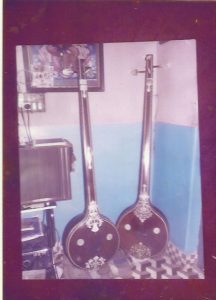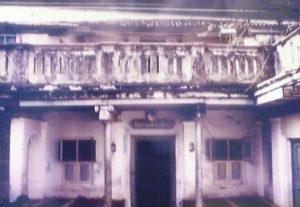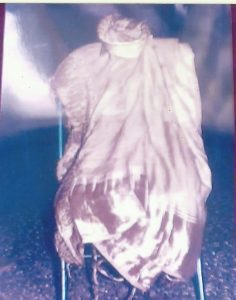Gayakasikhamani Harikesanalloor Dr. L. Muthaiah Bhagavathar (1877-1945)
Sri Muthaiah Bhagavathar was born on 15th November 1877, at Punalveli, Thiruvarur, the birthplace of the “Trimurthis of Carnatic Music”.
He was born as the son of Sri Lingam Iyer and Smt Anandavalli Ammal. Bhagavathar lost his father at the age of 7. Thereafter he migrated to Harikesanallur in Tirunelveli district, along with his uncle Sri Lakshmana Suri. From the age of 9 years, he studied music as well as did Vedadhyayana (learning theology) and acquired knowledge in Telugu, Kannada and Sanskrit.
At the age of 19, he performed a concert in the court of Sri Moolam Thirunal and was honoured with Rs 1000, Thoda and Veerashringala. He married Sivakamiyammal and the couple was blessed with a baby girl. However the baby died of smallpox at a very young age. He later adopted his nephew Sri Vaidyalingam as his adopted son. Bhagavathar was known for his “majesty of voice”, “majesty of form”, “mastery of language” and “mastery of music”. He excelled in the field of Harikatha, examples are “Satinulochana”, “Valli Kalyanam”, “Thyagaraja Charitham”, “Draupadi Manasamrakshanam”, “Ushaparinayam” and “Kausalyakalyanam”.
In 1927, he performed in the court of the Maharaja of Mysore, Sri Krishna Raja Wadiyar IV and was appointed as the Chief court musician. As per the instructions of the Maharaja, he composed 114 krithis in Kannada in praise of Chamundi Devi, the matron goddess of the Mysore Dynasty. They are popularly known as “Chamundeshwari Ashtothara kirtanams” (Stuti kirthanam 6 + 108 ashtothara krithis ). He also composed and arranged the Sivashtothara Kirthanam. The Maharaja of Mysore honoured him with the title “Gayakashikhamani” in recognition of his excellent work of creating the “Ashtothara kirthanams”. Apart from these, Tanavarnams, Padavarnams and Daruvarnams (written only by Muthaiah Bhagavathar) are also his valuable contributions to the music world. His popular compositions include krithis glorifying Murugan, Saraswati and Kali. The Madras Music Academy was started in the year 1929 by K V Krishnaswamy Iyer, Sri Raghavan, Sri T V Subbarao and Sri Muthaiah Bhagavathar and Bhagavathar became its first Principal. He was also the second President of the Academy.
During the discussions in the Academy, which included many eminent persons, Bhagavathar was in the lead. A concert of budding artists was held in the evenings. This has grown into the “Music Academy Season” as we see it today. In 1932, he was awarded the title “Sangeetha Kalanidhi”.
In 1934, on the occasion of Sri Karthika Thirunal’s wedding Bhagavathar was invited to present the history of Travancore as a “Harikatha”. In the Harikatha presented by Bhagavathar under the title “Chithrodayam”, Bhagavathar sang several beautiful krithis of Sri Swathi Thirunal describing the merits of the kings starting with “Vaivasvata Manu”. His adopted son Vaidyalingam and Nellayi T V Krishnamoorthy accompanied him during this performance. The Maharani was overjoyed with this performance and asked him to be appointed as the “Aasthana Vidwan” to collect and edit the works of Sri Swathi Thirunal. Being the “Aasthana Vidwan” in Mysore, Bhagavathar agreed that he could take up the job after a short delay. For this research assigned by the Maharani, he stayed in the “Golf Links” in Thiruvananthapuram and collected literature by visting “Amma veedu”. He edited Sri Swathi Thirunal’s compositions in three stages. Many of Sri Swathi Thirunal’s works were in extremely dilapidated conditions. In spite of the odds, he was able to edit around 225 compositions. Sri Narayana Bhagavathar, Sree Vidwan Sreenivasan and Sri Nellai T V Krishnamurthy were involved in collecting and notating the works edited by Bhagavathar. Each work was sung at least 50 times before Bhagavathar. After the corrections were made, Sri Nellai T V Krishnamurthy would sing the krithi before the Maharani and once she approved, permission was obtained for printing it. It was observed that most of the compositions were set in Bhairavi, Saveri, Kalyani and Sankarabharanam. To avoid the repetition and boredom, seeking permission from the Maharani, Bhagavathar set some of them in melodious rare ragas. The works sung by Mullamottu Bhagavathar in the “Sopana” Style, during earlier days, were transformed by Bhagavathar into works that we hear in concerts today. The works in Saraswati Manohari, Umabharanam, Kunthalavarali, Mohanakalyani, Hamsanandi and Vachaspathi are some examples. This project was completed in 1938.
In response to the Maharani’s question as to what should be done to popularise the works of Swathi Thirunal, Sri Bhagavathar gave the following suggestions: 1. To start an academy in the name of the Maharaja and to give the students, who graduate from the academy, an opportunity to work as music teachers in schools. 2. To appoint eminent musicians and performers (concert level) as Head Scholars in the Academy. On Bhagavathar’s recommendation, Sri Semmangudi Srinivasa Iyer, Vadakkancherry Sri Mani Bhagavathar, Kalyana Krishna Bhagavathar, Musiri Subramanya Iyer, Palakkad Mani Iyer, Rajamanikampillai and Nagaswaram Veeruchamipillai were appointed as Aasthana vidwans. Sri N V Narayana bhagavathar, Sri K R Kumaraswamy Iyer, Sri K V Keshava Bhagavathar, Nellayi T V Krishnamoorthy, Kalladakurichi Harihara Iyer, N G Seetharama Iyer and C S Krishna Iyer were appointed as Vocal Music teachers. Later, to teach Sanskrit, Sri Krishnamachary and Sri Ganesha Sharma were appointed. Sri Sankara Bhagavathar (Appu Bhagavathar) was appointed to teach the theories of Carnatic Music. From the time it was started in 1939, until its affiliation in 1999, the tution fees at the Swathi Thirunal Academy was just Rs 5/-. This was also as per Maharani’s promise to Sri Muthaiah Bhagavathar.
Swathi Thirunal Academy Thiruvananthapuram, was started in 1939 and Sri Muthaiah Bhagavathar was appointed as the Founder and First Principal. He wrote the opening work ‘Ananthapadmanabham Aasraye’, set in Arabhi ragam as a prayer to be sung every day in the college. A huge arm chair was made especially for him, (Bhagavathar was 7 feet tall) and this can be seen in the academy even today. Initially in the Navaratri Mandapam, two eminent musicians used to sing alternately Ragam, Pallavi, Neraval, Manodharma Swara and so on. This was meant to be a healthy competition. Later, when it started becoming an unhealthy competition, Sri Bhagavathar decided to change this pattern and transformed it into concerts. The “Navarathrimandapakkacheri” is still held during the Navarathri Festival Season in Thiruvananthapuram.
He recommended the appointment of Shri Semmangudi Srinivasayya as the next Principal, before he returned to Mysore in 1942, owing to ill-health. The first volume of Swathi Thirunal Krithis was published during the reign of Muthaiah Bhagavathar and the next two volumes were published during the reign of Semmangudi Srinivasayya. At the request of the Diwan Sri C P Ramaswamy Iyer, Bhagavathar presented a “grantha” of music called “Sangeetha Kalpadrumam” (in Tamil) and he was honoured with a D Litt degree by the University of Travancore for this Tamil Treatise in 1943.
He was the first to be honoured – Sangeetha Kalpadrumam consists of 2 parts, Part 1 has 8 chapters, which includes, Upodghaatham, Naada Prakaranam Shruti Prakaranam, Swara Prakaranam, Varnalankara Prakaranam, Swaraprasthara Prakaranam, Jaati Prakaranam and Gita Prakaranam. Part 2 has the Prabandha Prakaranam, Vaadya Prakaranam, Thaala Prakaranam, Raaga Prakaranam, Narthana Prakaranam and Vaggeyakaaraadilakshana Prakaranam. This book was translated and published in Malayalam by Sri Venketasubramonia Iyer.
Bhagavathar’s contribution to the world of Cinema In the early days, conversation and communication in movies was in the form of songs. A movie would have 35-36 songs. Many such songs were written for films like “Sangeetha Lavakusha”, “Radhakalyanam”, and “Thirumangayalvar” by Sri Bhagavathar. In all these movies, the songs were sung by Sri Nellai T V Krishnamurthy who also played the roles of Lava, Krishnan and Thirujnanasambandar, respectively. In the film, Thillana Mohanambal, there is a part where the character Sikkil Shanmugasundaram (a Nagaswaram player) is challenged by some westerners who ask if he can perform something that would appeal to them. Sri Bhagavathar’s western note “Ga ma ga ri ga pa ri ga sa” was an “incidental krithi” composed in that situation. The English notes were later made famous by Madurai Mani Iyer. Sri Bhagavathar can be described as one of the best orators of the post-Thyagaraja period. This is because he is a great man who has contributed the most musical forms in various genres. (A person who is able to compose a work and sing it himself is called an orator.)
Salient Features of his compositions: 1. His melodious krithi “Vallinayakane” in Shanmukhapriya, was heard by the Mysore Maharaja and became the reason to bring Sri Muthaiah Bhagavathar to the court of Mysore. 2. There will be no music lover who has not heard the composition “Himagiri Thanaye” in Shuddha Dhanyasi raga. This devotional song written in Malayalam is also very popular in ballet. 3. The form of the melody in his krithis is in a way that is easily understood by the learners though the syllables. 4. His contributions are as simple as Thyagaraja’s, as complex as Dikshithar’s and as short but insightful as that of Syama Sastri’s krithis. 5. Similar to Muthuswamy Dikshitar’s Navagraha krithis, Sri Muthaiah Bhagavathar has contributed seven compositions under the title “Vaarakeerthanams”, in praise of the seven grahas (7days of the week). These are a little simpler in terms of melody selection and literary style. 6. In all his ragamalikas, the chittaswaram is sung till the Laghu; thereafter the ending swaras of the first raga are sung from the dhrutham onwards.
The first music school in India was started by Sri Muthaiah Bhagavathar in 1920 in Madurai, Tamil Nadu, called the Thyagaraja Sangita Vidyalaya, on the lines of a Gurukulam. The famous musicians who studied here were Madurai Mani Iyer and Sankara Sivam(T N Seshagopalan’s Guru). Almost 23 ragams owe their existence today, to this great composer. These can be categorised as Popular and Non-Popular. Popular ones: 1. Niroshtha – The lips should not collide while singing the vocals and lyrics of the krithi in this raga. Rajaraja radhithe is a popular song in Niroshtha. 2. Gowdamallar – Sarasamukhi 3. Vijayanagri – Vijayambike 4. Karnaranjini – Vanchathonuna 5. Hamsanandi – Sachamara What is to be propagated now? Guharanjini, Veenadhari, Nagabhushani, Pashupatipriya, Harinarayani, Hamsadeepakam, Manorama, Urmika, Sarangamalhar, Gurupriya, Hamsagamani, Mayapradeepam, Sumanapriya, Vijayasaraswati, Budhamanohari, Alankari, Chakrapratipadam, Kokila Bhushani Sri Bhagavathar was also skilled in playing Gottu, Violin and Mizhav. Sri Muthaiah Bhagavathar was as glorious as a Maharaja in all aspects of form, decoration and lifestyle. Sri Nellai T V Krishnamoorthy believed that Maharaja Swathi Thirunal was reborn as Muthaiah Bhagavathar and spread his hymns.
Life Sketch of Shri. Muthaiah Bhagavathar in MALAYALAM – Click here
Life Sketch of Shri. Muthaiah Bhagavathar in TAMIL – Click here
Collection of photographs

Deities worshipped by Shri. Muthaiah Bhagavathar

Goddess Chamundeswari – Upasana Devi of Shri. Muthaiah Bhagavathar



Maharani Sethu Parvati Bayi was a visionary patron of music who nurtured and uplifted the art form with great dedication. Her Highness, Smt. Sethu Parvati Bayi, was instrumental in supporting the research on Swathi Thirunal Kritis. Following her esteemed suggestion, Shri Muthaiah Bhagavathar devoted four years (1934–1938) to meticulously completing this significant task. In accordance with Bhagavathar’s recommendations, the Swathi Thirunal Sangeetha Academy was founded in 1939, marking a milestone in musical education and Shri Muthaiah Bhagavathar was appointed as the founder and 1st principal of the above institution. With unwavering commitment, Maharani Sethu Parvati Bayi upheld two noble promises: (a) A nominal fee of only 5 Rupees would be charged, ensuring affordability for aspiring musicians. (b) Students pass out from the academy would be appointed as music teachers in various schools, fostering the spread of musical knowledge. These guiding principles remained steadfast until 1999, when the academy became affiliated with the university. The invaluable contributions of Sir C. P. Ramaswamy Iyer, the Diwan at the time, further strengthened this noble endeavor. It is only fitting that musicians and ardent lovers of music take a moment each year to honor and remember these three distinguished personalities, whose dedication and vision continue to resonate in the world of music.

Kochi Indian Express paper report November 3, 1990.

Family photo

The first D.Litt. recipient in India

Sashtyabdapoorthi Photo

Sashtyabdapoorthi Photo

Chamber Music – Bhagavathar playing Violin

Chamber Music – Bhagavathar is accompanying in Violin for Jalatharangam Concert

Chamber Music – Bhagavathar playing Gottuvadyam

Chamber Music – Vocal Concert

Two Thamburas – Rama and Lakshmana

The house on 100 Meter’s Road, Mysore, which stood witness to Harikeshanallur Muthaiah Bhagavathar’s creation of the Chamundeswary Ashtottara Kritis and Sivashtottara Kritis.

Muthaiah Bhagavathar with his contemporaries at the Court of Mysore

Bhagavathar’s perfume supplier Krishna Rao and his wife

Costumes of Shri. Bhagavathar

Group photo taken at Golf Links, Travancore where Harikeshanallur Muthaiah Bhagavathar resided between 1934 and 1938 while conducting research on Maharaja Swathi Thirunal’s kritis.

Sangeetha Lava Kusha

The Tamil film “Sangeetha Lava Kusha”, which was initially named “Lavakusa” and was later renamed due to Muthiah Bhagavathar’s musical contributions, was released in 1934. The film was directed by S. Soundararajan for Tamil Nadu Talkies, was based on the Uttara Ramayana and was notable for Muthiah Bhagavathar’s composition of 63 songs. In this film, Shri. Nellai T. V. Krishnamoorthy (Nephew and direct disciple of Bhagavathar) acted as Lava and sung nearly 36 songs in 3 Kattai.

Shri. Bhagavathar’s another film named Thirujhana Sambandar in which Shri. Nellai T. V. Krishnamoorthy acted as Thirujhana Sambandar and sung songs.

Nellai T. V. Krishnamoorthy as Nammalvar in Bhagavathar’s Film Thirumangai Alwar

Nellai T. V. Krishnamoorthy as Nammalvar in Bhagavathar’s Film Thirumangai Alwar

Latest newspaper article published in Janmabhumi
Rare Collections of Bhagavathar’s Photos




Direct Disciples of Shri. Muthaiah Bhagavathar

Shri Madurai Mani Iyer, a diligent and dedicated disciple of Muthaiah Bhagavathar at the first Sangeetha Vidyalayam in Madurai, rose to fame as a renowned vocalist. He popularized many of Bhagavathar’s Kritis, giving special emphasis to the note ‘g, mg, rg’ in a distinct Western style (An incidental Kriti in Sankarabharana Raga by Shri. Muthaiah Bhagavathar)

Shri S. G. Kittappa was Shri Muthaiah Bhagavatar’s most beloved student. This is evident from the Kriti Thandava Darshanamo in Jonpuri Raga, which was gifted to Kittappa without Bhagavatar’s usual signature, Harikesa—a special mark of the high regard with Shri. Kittappa.

Shri. Nellai T. V. Krishnamoorthy (Nephew and direct disciple. Description given in life sketch.)

Shri. Sankara Sivam – another eminent musician from Madurai Sangeetha Vidyalayam. Among the disciples of Shri Sankara Shivam, Shri T. N. Seshagopalan emerged as a distinguished musician, flourishing in the world of classical music.

Smt. Parashala B. Ponnammal holds a pioneering place in the history of Swathi Thirunal Sangeetha Academy as its first female student and later, its first female teacher. She also made history as the first woman artist to perform at the esteemed Navarathri Mandapam concert.
- Smt. Vaikkom Valliyammal (She was the gayaka student at Swathi Thirunal Music Academy. But I regret, I couldnt collect more information about her)
